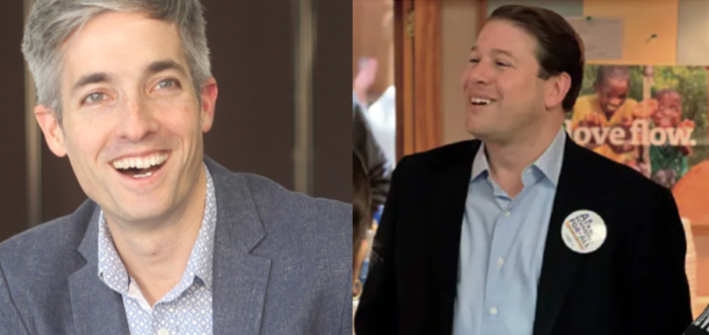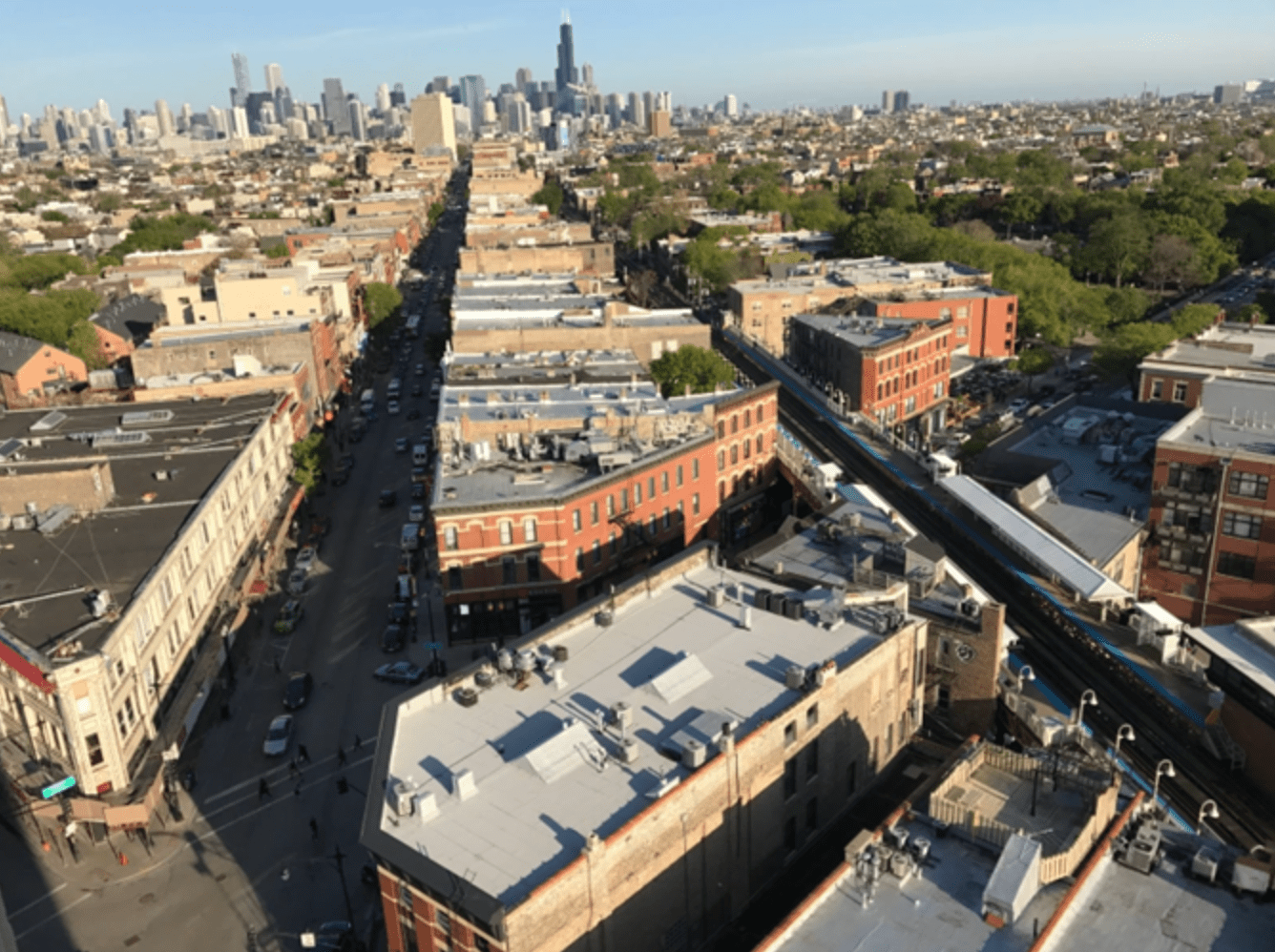As part of our 2023 Election Coverage, Streetsblog Chicago sent a questionnaire out to every candidate running for alderperson. Today, we’re sharing responses from candidates in Near North and Northwest Side districts, including wards 1, 43, and 44.
We asked about their plans to restore CTA ridership, what actions they would take to reduce fatal crashes, and if they supported additional protected bike lanes in their ward. We also asked if they supported more affordable housing options near transit, including Equitable Transit Oriented Development, and allowing Accessory Dwelling Units and three-flats to be built in every neighborhood. See the full set of questions at the bottom of this post.
You can see the full responses from candidates in every ward here.
Here are our writeups of the responses:
- Far South Side (Wards 6, 8, 9, 10 and 21)
- Near North and Northwest Side (Wards 1, 43, and 44)
- South Lakefront and Mid South Side (Wards 4, 5, 16, and 20)
- Mid North Side (Wards 33, 40, 46, and 47)
- West Side (Wards 24, 25, 26, 30 and 37)
- Far North Side (wards 48, 49, and 50)
- Southwest Side (wards 11, 12, 13, 15, 18, and 22)
- Northwest Side (wards 35, 36, 38, 39, and 45)
Ward 1: Logan Square, Wicker Park, Humboldt Park, and West Town

About the race: Chicago’s 1st Ward covers portions of Logan Square, Wicker Park, Humboldt Park, and West Town. Streetsblog received responses from Daniel La Spata, the incumbent, and Stephen ‘Andy’ Schneider, a community advocate and president of Logan Square Preservation. Sam Royko and Proco “Joe” Moreno are also running but did not respond to outreach from Streetsblog. Block Club is covering the race here.
CTA Ridership:
- La Spata pointed to efforts during his term to add a substation in Wicker Park to improve speed on the Blue Line. He also expressed support for a return to GPS tracking for CTA busses (to address ghost buses), as well as additional investment in service and fare reductions.
- Schneider observed that hiring was the driving issue behind the CTA’s issues and suggested that the agency needs to “intensify hiring,” although he didn’t provide details on how that might be accomplished. He also expressed support for a resolution requiring CTA representatives to appear regularly before the City Council.
Traffic Safety: Both candidates expressed support for additional safety upgrades.
- Schneider observed that Chicago’s traffic violence is “absolutely unacceptable.” He pointed to his efforts to develop proposals for a bike and pedestrian priority network along the city’s historic boulevard system, and his advocacy for “Safe Streets” infrastructure on Logan Boulevard.
- La Spata commented that he uses a bike as his most common form of transportation. He noted that he has been a strong advocate of protected bike lanes, and secured barrier-protected lanes on Milwaukee Ave. and Logan Square Boulevard during his term.
Bike Lanes: Both candidates also endorsed expanded bike lanes.
- La Spata observed that he is the only council member that bikes to City Hall and suggested protected lanes on Armitage and California Avenues.
- Schneider also expressed support for additional lanes, although he didn’t mention any specific sites in the ward. He backed lower speed limits and camera enforcement to protect cyclists.
Equitable Transit Oriented Development:
- Schneider wrote that “my track record speaks for itself” on ETOD, pointing to his advocacy for the development of the Lucy Gonzalez Parsons Apartments in Logan Square. He argued that the TOD rules should go even farther, with further reductions in parking near transit and greater density incentives.
- La Spata noted that he was a lead sponsor of the Connected Communities ordinance which recently expanded TOD incentives citywide, and that he was now working to ensure TOD-developments emerge across the ward. He also highlighted the fact that TOD can’t succeed without transit—and that it remains important to hold the CTA accountable to its reliability goals.
Accessory Dwelling Units: Both candidates endorsed a citywide ADU expansion.
- La Spata celebrated the success of the ADU pilot in the 1st Ward to-date and noted that residents have been “incredibly eager” to make use of the program. In addition to expanding the program citywide, he noted that the city should provide financial assistance to help turn applications into units.
- Schneider also expressed his support for a citywide expansion.
Legalizing 3-Flats:
- Schneider commented that 2- and 3-flats are the “backbone” of Chicago’s housing stock, and a critical piece of ensuring affordability. He noted that even after the most recent zoning changes, 2-and 3-flat construction should be more widely allowed and easily permitted.
- La Spata agreed that 2 and 3-flats should be legalized citywide. He also pointed out that he created the first minimum density thresholds in the city near The 606/Bloomingdale Trail, to help prevent de-conversions and preserve existing housing supply.
Ward 43: Lincoln Park, Old Town, and Gold Coast

About the race: Chicago’s 43rd Ward covers Lincoln Park, Old Town, and Gold Coast. Streetsblog received responses from incumbent Timmy Knudsen, who was recently appointed by Mayor Lightfoot; Rebecca Janowitz, a public safety and community leader; Steve Botsford a partner in a small real estate investment business; and Steven McClellan, a community leader and member of the Local School Council at Lasalle Language Academy. Brian Comer and Wendi Taylor Nations are also running, but did not respond to outreach from Streetsblog. Block Club is covering the race here.
CTA Ridership: Candidates were all over the place on their suggestions to address the CTA’s woes.
- Janowitz suggested lowering fares and ensuring it was easy for cyclists to more their bikes on buses and trains.
- Botsford pointed to two key problems for the CTA: safety and reliability. He suggested replacing funds spent on private security with additional uniformed CPD officers who can enforce rules directly, and adding panic buttons to CTA stations. On reliability, he suggested that the CTA condense the number of bus lines while increasing the frequency of service, reducing travel times and increasing reliability overall (Streetsblog note: this is an approach that has been used successfully in Baltimore, among other places).
- McClellan highlighted the challenges associated with CTA hiring, a key contributor of to the agency’s reliability issues. He suggested the agency offer greater hiring incentives and also stressed the importance of improving scheduling accuracy.
- Knudsen noted that he co-sponsored a resolution to pressure CTA President Dorval Carter to appear regularly at City Council hearings. To address the agency’s staffing woes, he endorsed better benefits, improved management-labor relations, and more holistic training. On safety, he proposed that CPD create a dedicated transit district, and backed non-uniformed officers and unarmed security guards to “increase the police presence across the CTA system in a non-threatening way.” He also called for a move to real-time tracking to address ghost buses and trains.
Traffic Safety: Candidates differed on the best ways to protect cyclists and pedestrians.
- Janowitz said she would emphasize improved lighting, and the prosecution of dangerous drivers.
- Botsford noted a series of infrastructure upgrades that he’d support, including protected bike lanes, crosswalk improvements, and automated ticketing for cars parked near bike lanes or to close to crosswalks.
- McClellan expressed concern about pedestrians, writing that “both cyclist[s] and drivers tend to think the other is at fault when both parties need to focus on making sure the road is safe for pedestrians.” He endorsed better education for cyclists and drivers.
- Knudsen endorsed state legislation mirroring Massachusetts to require all IDOT and CDOT projects to increase or encourage pedestrian, cyclist and transit use. He called for an end to “more lanes and higher speed limits” as primary transportation goals. He also noted that he was working with local high school students to pass an anti-idling ordinance, penalizing drivers for sitting in park with their engines on (and also gumming up traffic).
Bike Lanes: All candidates endorsed additional bike lanes, and Janowitz, Botsford and McClellan all backed a protected bike lane on Clybourn.
- Janowitz said she’d ask cyclists for suggestions, proposed Clybourn, and that while the Dickens Greenway has been controversial, “where ever the 606 passes through our ward to connect to the park and lakefront we need to make sure that cyclists are protected.”
- Botsford laid claim to being in the top 1% of Divvy riders, and said he’d be interested in protected lanes for Lincoln, Clark, Clybourn Sheffield, and Larrabee.
- McClellan suggested “Clark, Armitage and/or Clybourn.”
- Knudsen backed more bike lanes and emphasized the benefits of non-motorized lanes (i.e., not shared with cars). He suggested connecting the 606 to the Lakefront Trail “based on a routing determined by innovative urban planners in consultation with bicycling advocates and the community.”
Housing: All three candidates expressed support for Equitable Transit Oriented Development and the Citywide ADU Expansion. Janowitz, Botsford and Knudsen all endorsed legalizing three flats.
- Janowitz endorsed legalizing 3-flats, and also expressed expedited review for TOD applications.
- Botsford noted that he happily lives in an Accessory Dwelling Unit. As a bonus, he also supported ending mandatory parking minimums citywide.
- McClellan didn’t respond to the 2- and 3-flat question, but he expressed support for measures to increase affordability and economic opportunity citywide.
- Knudsen was emphatic in his support of the ADU expansion, writing “Yes. we should not waste more time in doing so.” He expressed strong support for ETOD and legalizing 3-flats.
Ward 44: Lakeview

About the race: Chicago’s 44th ward is largely comprised of Lakeview. Streetsblog received responses from both candidates running: Bennett Lawson, outgoing alderperson Tom Tunney’s Chief of Staff, and Nathan Bean a paralegal and student at DePaul. Bean was kicked off the ballot after the Chicago Board of Elections ruled he failed to file the proper paperwork. Bean is challenging the ruling in court and will run as a write-in candidate if he’s unsuccessful. Block Club’s coverage is available here.
CTA Ridership:
- Lawson said that he would focus on improving CTA reliability, increasing staffing for both CTA and CPD personnel, and improving technology. In the longer term, he suggested expanding service, fare incentives for low-income riders, and partnerships with community groups to promote the CTA and concerns or misconceptions.
- Bean would require CTA leadership to meet with the City Council, and increase pay for staff. He also suggested working with the federal government to declassify Marijuana as a schedule 1 drug, “so that CTA employees won’t be fired for enjoying a little during their time off.”
Traffic Safety:
Both candidates endorsed additional protected bike lanes.
- Lawson expressed support for additional protected bike lanes but wrote that “we need to have a conversation as a community” to determine where those lanes should be located. Lawson also the expansion of pedestrian-only zones and increased enforcement of traffic laws to crack down on speeding and reckless or distracted driving.
- Bean suggested protected lanes on Halsted, Broadway, Clark and Southport.
Equitable Transit Oriented Development:
- Lawson expressed support for ETOD and highlighted the Red Purple Modernization program as an opportunity to add density near transit and increase affordability in the neighborhood.
- Bean endorsed additional ETOD efforts and suggested that all new buildings reserve 20 percent of units to be rented at $1800/month.
Accessory Dwelling Units: Both candidates agreed that the ADU pilot program should be expanded citywide.
- Lawson also suggested some thoughtful ways to increase the program’s scope. He proposed adding attic conversions to the program, as well as allowing residents to convert coach houses larger than 700 square feet as part of the program.
Legalizing 3-Flats:
- Lawson hedged, writing “yes,” but then noted that he was “concerned about the impact in a specific area of my ward.” He noted that the quadrant of Sheffield/Racine/Diversey/Belmont, has been zoned for single-family homes, and worried that legalization of 3-flats might prompt teardowns of older affordable units.
- Bean expressed unqualified support for legalizing two- and three-flats.
The Questions We Asked
We asked all candidates the following questions:
- CTA Ridership: The CTA has faced ongoing concerns about reliability and safety. Ridership still hasn’t recovered from the pandemic and ended 2022 at just 57 percent of 2019 levels. What actions would you take to improve CTA performance and ridership?
- Traffic Safety: In 2022, there were more than 31,000hit-and-run crashes in Chicago, and 31 pedestrians and 8 cyclists were killed on city streets. Do you believe the city should do more to protect pedestrians and cyclists? If so, what additional traffic safety measures would you support in your ward?
- Protected Bike Lanes: In 2022, the Chicago Department of Transportation added just 7 miles of protected bike lanes, falling short of its own goal. Do you believe Chicago should add more protected bike lanes, and if so, what streets in your ward would be good candidates?
- Equitable Transit-Oriented Development: Equitable Transit Oriented Developmentcan help ensure more Chicagoans can benefit from living near CTA stations and high-frequency bus lines. Do you believe more should be done to support development (including of affordable units) near transit in your ward? If so, what specific actions would you support?
- Accessory Dwelling Units: The City’s Additional Dwelling Unit (ADU) ordinanceallows homeowners to add a coach house, or backyard apartment to their property. This can help increase affordable housing options and reduce displacement, but the program is currently limited to five pilot areas. Do you support expanding the ADU ordinance citywide?
- Legalizing 3-Flats: 2- and 3-flats are Chicago’s most affordable housing stock. But in many neighborhoods near CTA and Metra stations, particularly on the North, Northwest and Southwest sides, 2 and 3-flats are illegal to build due to single-family zoning rules. Do you support legislation legalizing 2-and 3-flats citywide?
- Other: Please add any other positions you have on transportation or related housing issues that you think voters should know about.

Did you appreciate this article? Please consider making a tax-deductible donation to help fund Streetsblog Chicago's next year of publication. Thanks!






